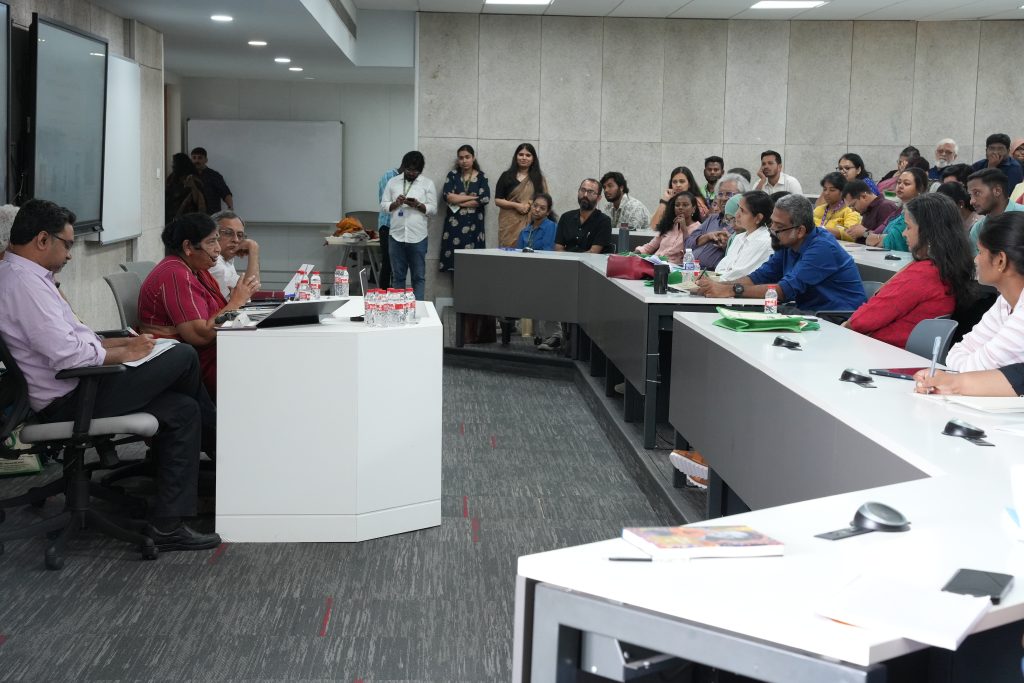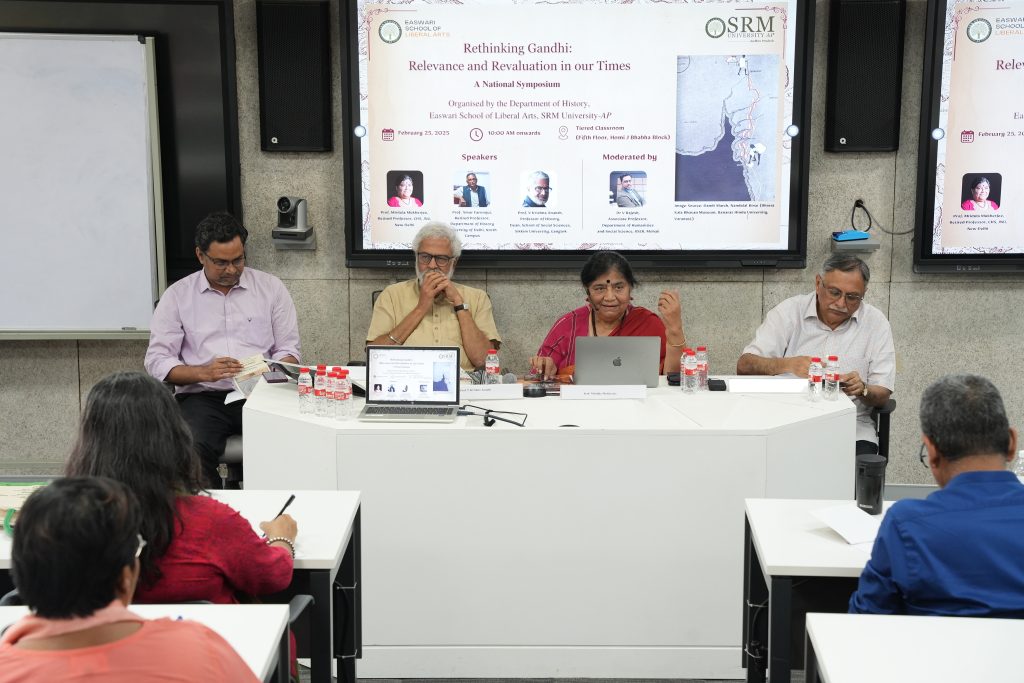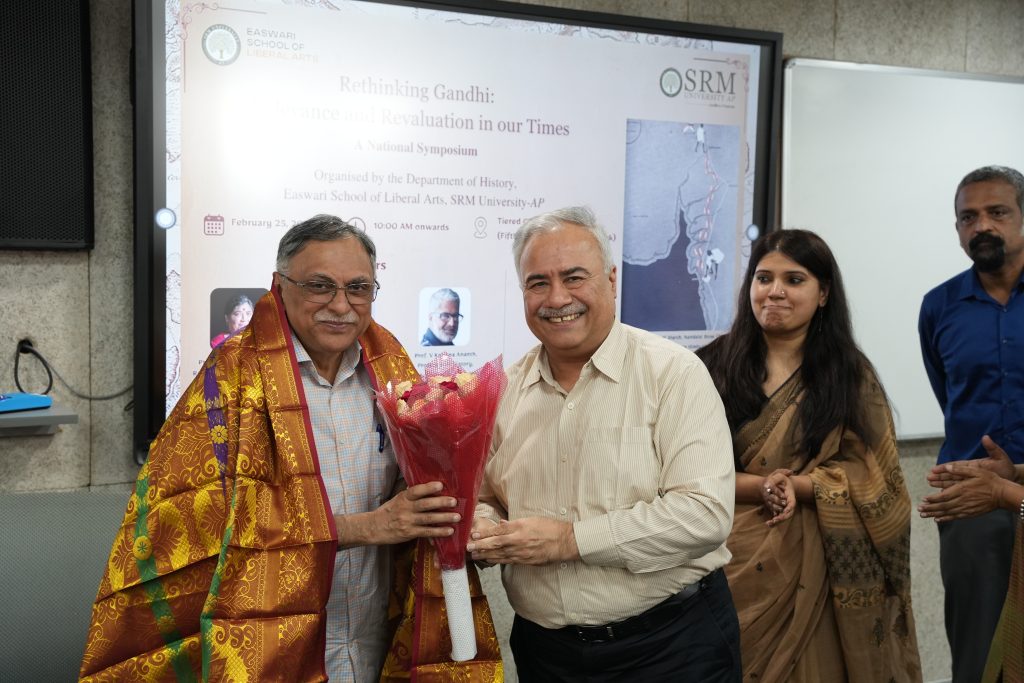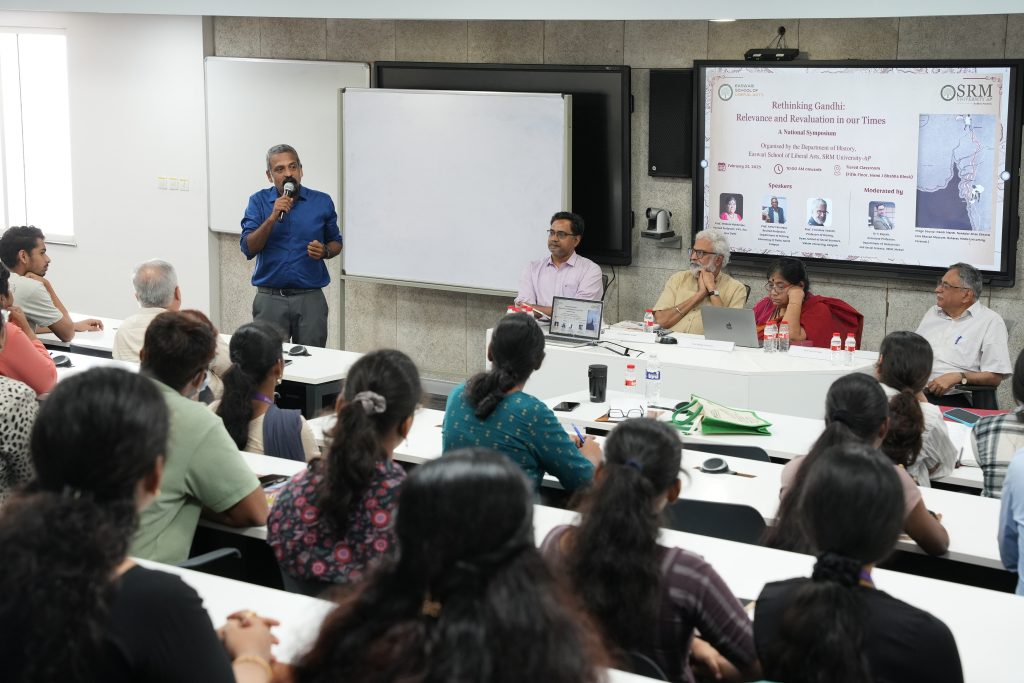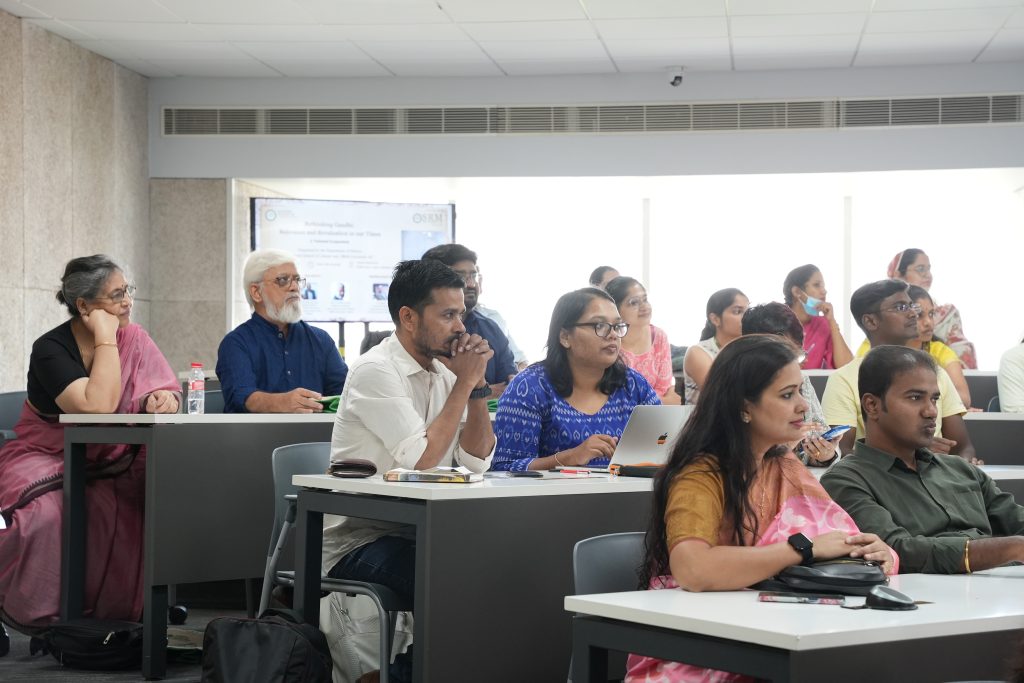- RadiomixNet for Advanced Pneumonia Diagnosis February 27, 2025
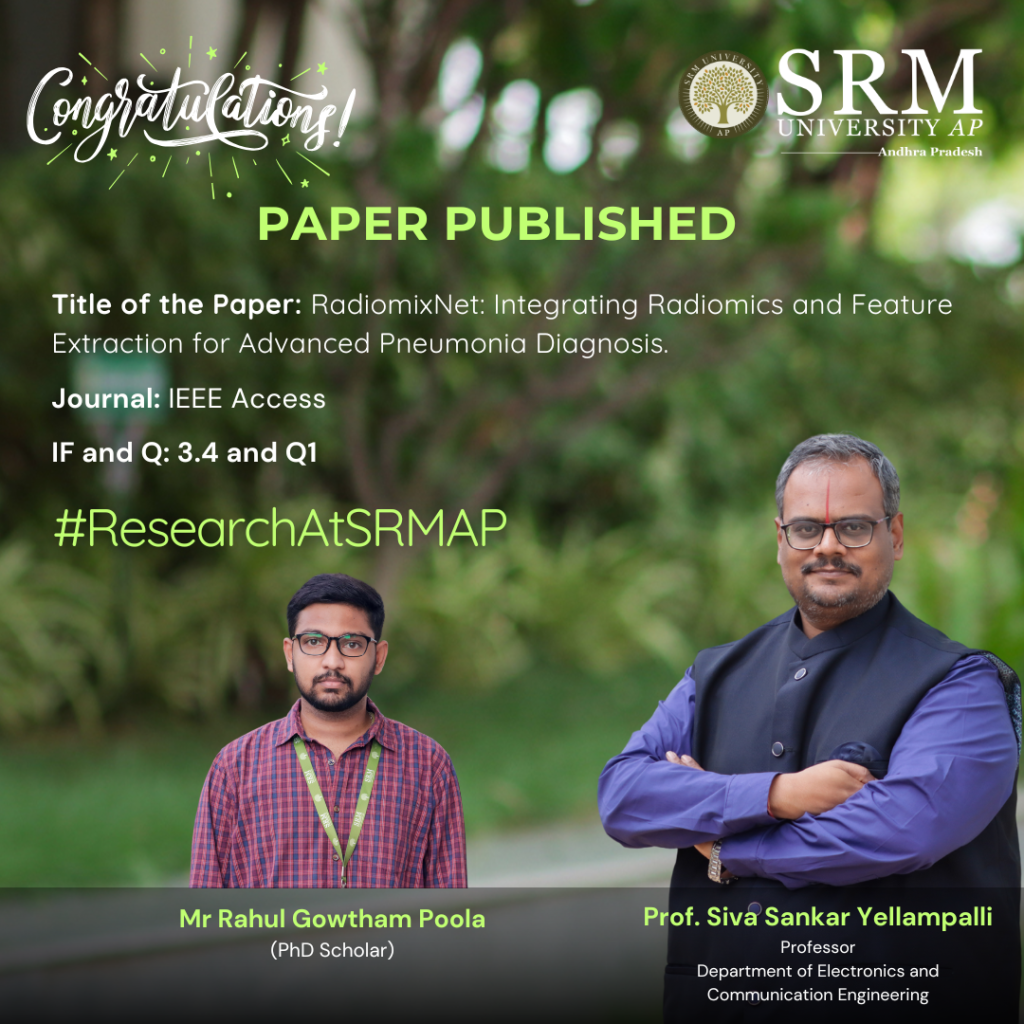
The research team from the Department of Electronics and Communication Engineering has published a paper titled “RadiomixNet: Integrating Radiomics and Feature Extraction for Advanced Pneumonia Diagnosis” in the journal IEEE Access with an impact factor of 3.4. Prof. Siva Sankar Yellampalli, Professor of Practice, and Mr Rahul Gowtham, PhD Scholar, have worked on RadiomixNet, a smart computer-assisted system designed to help doctors diagnose pneumonia more accurately using chest X-ray images.
Abstract
The research presents RadiomixNet, a pneumonia diagnosis framework integrating radiomics-based feature extraction with advanced classification techniques. Chest X-ray images are pre-processed using denoising, resizing, and enhancement methods to ensure uniformity and high image quality. Radiomics features are extracted using Gray Level Co-Occurrence Matrix (GLCM), Gray Level Size Zone Matrix (GLSZM), Gray Level Run Length Matrix (GLRLM), and Gray Level Dependence Matrix (GLDM). Power Spectral Density (PSD) analysis using Burg, Yule Walker, and Welch techniques enhances the understanding of frequency characteristics within the radiomics feature matrices. To classify pneumonia cases, machine learning classifiers such as Bernoulli Naïve Bayes, Random Subspace Boost, Quadratic Discriminant, and Gradient Boosting are employed. Among these, Gradient Boosting demonstrated superior performance, achieving a Cohen’s Kappa of 0.93, MCC of 0.88, Youden’s Index of 0.82, and a Log Loss of 0.27. The proposed methodology enhances diagnostic accuracy, reduces variability in pneumonia detection, and provides a structured approach to feature-based pneumonia classification.
Explanation of the Research in Layperson’s Terms
Traditional diagnosis relies on a doctor visually examining the X-ray, which can sometimes lead to misinterpretations. RadiomixNet improves this process by using advanced image processing and artificial intelligence (AI) techniques.
- Preprocessing the X-rays – Before analysis, we clean the images by removing noise (unwanted distortions), adjusting brightness, and resizing them to a standard format. This ensures all images are high quality and uniform.
- Generating More Training Data – Since AI models need a large amount of data to learn effectively, we use Generative Adversarial Networks (GANs) to create additional synthetic X-ray images. This helps balance the dataset and improve the model’s ability to detect pneumonia accurately.
- Extracting Hidden Patterns – The system breaks down X-ray images into tiny texture and shape details using advanced techniques like GLCM, GLSZM, GLRLM, and GLDM. These methods capture the structure of the lungs and highlight patterns that indicate pneumonia.
- Analysing Frequency Components – Similar to how an audio equalizer separates different sound frequencies, we analyze the X-ray’s frequency components using techniques like Burg PSD, Yule Walker PSD, and Welch PSD. This helps uncover hidden details in the images that may not be visible to the human eye.
- Making the Final Diagnosis – After extracting these detailed features, we use AI models to classify the images as “pneumonia” or “healthy.” We tested different models, including Naïve Bayes, Random Subspace Boost, Quadratic Discriminant, and Gradient Boosting. Among them, Gradient Boosting performed the best, making the most accurate predictions.
- Evaluating Accuracy – To ensure the system is reliable, we used various accuracy-checking methods such as Cohen’s Kappa, Matthews Correlation Coefficient (MCC), Sensitivity, Specificity, Log Loss, and Brier Score.
Practical Implementation/Social Implications of the Research
Practical Implementation:
RadiomixNet has the potential to be integrated into real-world healthcare systems to assist in pneumonia diagnosis. Its implementation can take place in various ways:
- Hospital Integration – RadiomixNet can be deployed in hospitals as a decision-support tool for radiologists. By analysing chest X-rays in real time, it can provide secondary validation, reducing diagnostic errors and improving accuracy in pneumonia detection.
- Telemedicine and Remote Diagnosis – The system can be integrated into telemedicine platforms, allowing doctors in rural or under-resourced areas to diagnose pneumonia remotely. Patients can upload their X-ray images, and RadiomixNet can assist in providing a preliminary diagnosis.
- Medical Imaging Centers – Radiology centers can incorporate RadiomixNet into their existing Picture Archiving and Communication Systems (PACS) to enhance diagnostic efficiency, reduce the workload of radiologists, and provide automated analysis.
- Edge Computing in Low-Resource Settings – Unlike deep learning models that require expensive GPUs, RadiomixNet is optimized for standard computing hardware. This makes it feasible for implementation in clinics and hospitals that lack high-end computational resources.
- Clinical Trials and Further Validation – Pilot studies in hospitals can validate RadiomixNet’s accuracy and reliability before widespread deployment. The system can be fine-tuned based on real-world patient data to improve its performance across diverse populations.
Social Implications:
- Early and Accurate Diagnosis – By improving pneumonia detection, RadiomixNet can enable earlier treatment, reducing complications and mortality rates, especially in high-risk populations such as children, the elderly, and immunocompromised individuals.
- Reducing Radiologist Workload – With increasing patient loads, radiologists often face diagnostic fatigue. RadiomixNet can act as an assistant, helping them focus on complex cases while automating routine pneumonia detection.
- Bridging the Healthcare Gap – In developing countries where expert radiologists are scarce, RadiomixNet can assist general practitioners and healthcare workers in diagnosing pneumonia without requiring extensive radiology expertise.
- Affordable and Scalable Solution – Since the system does not require expensive hardware, it can be implemented in low-resource settings, making advanced pneumonia detection accessible to a broader population.
- Pandemic Preparedness – Pneumonia is a major complication of respiratory infections like COVID-19. RadiomixNet can be adapted to detect pneumonia-related lung infections, aiding in large-scale screening during outbreaks.
By integrating RadiomixNet into healthcare systems, we can enhance diagnostic accuracy, improve patient outcomes, and make pneumonia diagnosis more accessible and efficient globally.
Continue reading →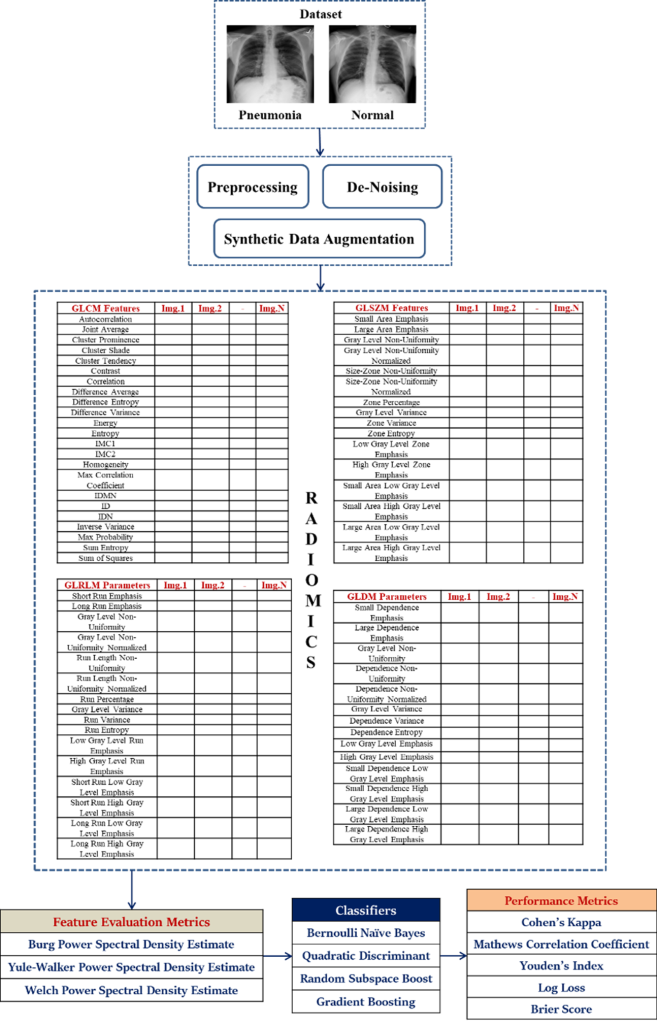
RadiomixNet Implementation Framework
- Patent on Pneumonia Diagnosis Using Deep Learning Techniques February 27, 2025
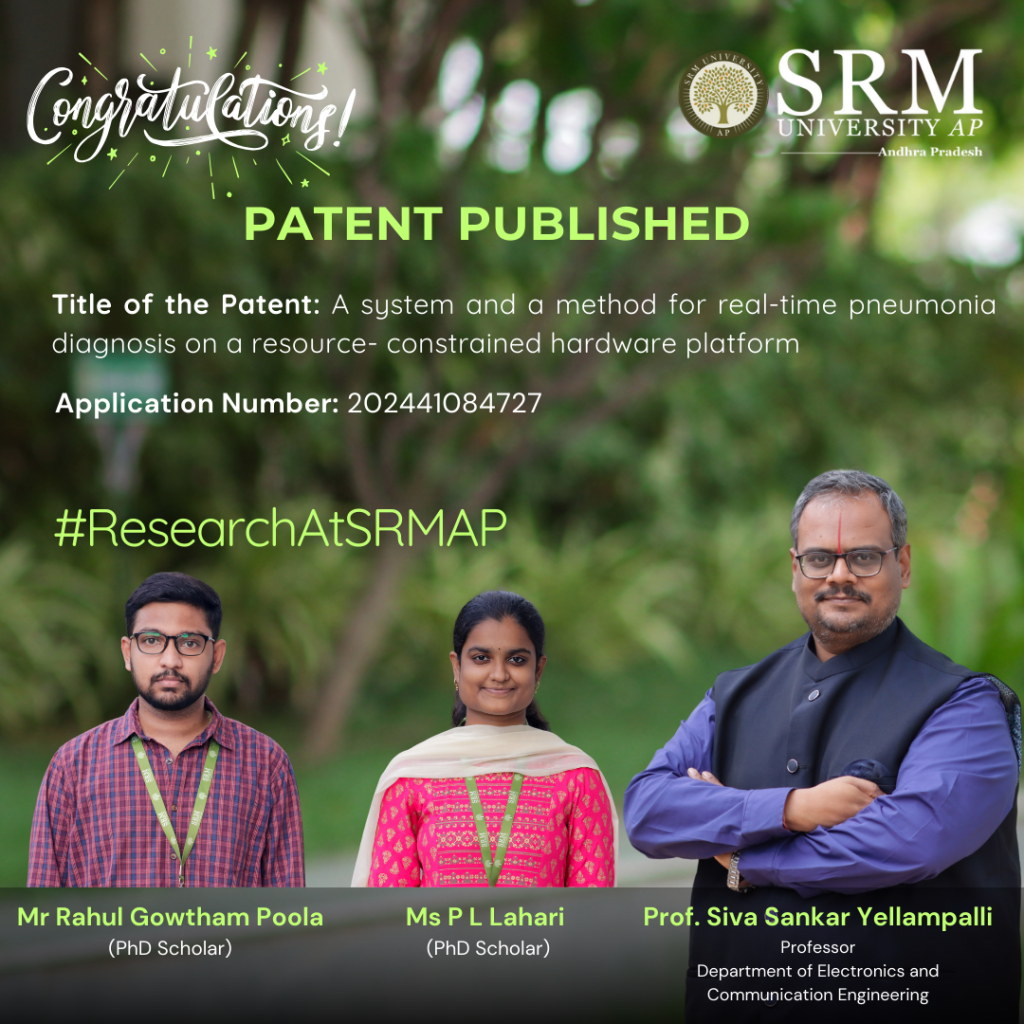 In the patent titled “A System and a Method For Real-Time Pneumonia Diagnosis On a Resource- Constrained Hardware Platform,” authored by Prof. Siva Sankar Yellampalli from the Department of ECE and his research scholars – Mr Rahul Gowtham Poola and P L Lahari, a novel diagnostic solution is presented to enhance pneumonia detection in low-resource settings. With Application No: 202441084727, this research explores the integration of advanced deep learning techniques with a compact microcontroller-based system, providing an innovative approach to improve healthcare accessibility and prompt medical intervention.
In the patent titled “A System and a Method For Real-Time Pneumonia Diagnosis On a Resource- Constrained Hardware Platform,” authored by Prof. Siva Sankar Yellampalli from the Department of ECE and his research scholars – Mr Rahul Gowtham Poola and P L Lahari, a novel diagnostic solution is presented to enhance pneumonia detection in low-resource settings. With Application No: 202441084727, this research explores the integration of advanced deep learning techniques with a compact microcontroller-based system, providing an innovative approach to improve healthcare accessibility and prompt medical intervention.Abstract:
The research focuses on the development of an innovative system for real-time pneumonia diagnosis leveraging advanced deep learning techniques integrated with edge computing technology. The proposed solution employs the MAX78000 microcontroller, a resource-constrained hardware platform, to deploy a sophisticated neural network model capable of analyzing chest X-ray images. The invention addresses the pressing need for accessible, cost-effective, and efficient diagnostic tools in under-resourced and remote environments. The system encompasses a complete diagnostic pipeline, including image acquisition via an onboard parallel camera module, real-time image processing, and display of results on a 3.5″ touch-enabled TFT screen. The deep learning model, optimized for the constraints of the MAX78000, performs real-time classification of chest X-ray images into either normal or pneumonia-affected categories. By operating entirely on-device, the system eliminates the need for high-power servers or internet connectivity, thereby reducing latency and dependency on external infrastructure. This research emphasizes portability, energy efficiency, and low-cost deployment, making the solution highly suitable for primary healthcare facilities, rural clinics, mobile health units, and disaster-response scenarios. With the ability to deliver immediate, accurate diagnoses, the device significantly enhances clinical decision-making and enables timely medical intervention. Additionally, the scalable and adaptable design of the system opens possibilities for broader medical imaging applications, extending its utility beyond pneumonia diagnostics. Experimental results showcase the performance of the neural network model, demonstrating prediction accuracies ranging between 66% and 97% for different test cases on the MAX78000 microcontroller. These findings underline the potential of the proposed system as a transformative tool for advancing point-of-care diagnostics in low-resource settings.
Explanation in Layperson’s terms.
The research presents a compact, affordable device that helps doctors quickly detect pneumonia by analyzing chest X-ray images in real-time. It uses advanced artificial intelligence (AI) technology, called deep learning, to examine the X-rays and determine whether a patient has pneumonia or not. What makes this device special is that it works entirely on a small, low-power microcontroller called the MAX78000, instead of needing powerful computers or internet access. The process begins when the device captures a chest X-ray image using its built-in camera. Then, the AI model, which has been trained to recognize patterns associated with pneumonia, analyzes the image. The results are displayed instantly on a small screen, allowing healthcare providers to make quick decisions. This real-time diagnosis can be life-saving, especially in emergency or rural settings where access to advanced medical equipment or high-speed internet is limited. Technically, this system combines AI and edge computing, meaning all the heavy processing happens directly on the device rather than in remote servers. This design keeps costs low, ensures patient data privacy, and makes the device highly portable and energy-efficient. The technology can work even in places with unreliable electricity, making it ideal for use in mobile health units, rural clinics, or disaster zones. Additionally, the invention can be adapted for diagnosing other diseases, showcasing its versatility in improving healthcare globally.
Practical Implementation
This research can be practically implemented as a compact, standalone device for diagnosing pneumonia in healthcare settings where access to advanced medical equipment is limited. It works as follows:
- Deployment in Rural Clinics and Mobile Health Units: The device can be used in clinics in remote or underserved areas where large X-ray machines and advanced computing resources are unavailable. It provides on-the-spot diagnosis.
- Point-of-Care Diagnostics: The portability and integration of image acquisition, AI-based processing, and display into a single unit make it ideal for bedside use in hospitals or during emergency care.
- Disaster Response: Its low-power and internet-free design make it a critical tool in disaster zones, refugee camps, or any setting where power and connectivity are unreliable.
- Telemedicine Integration: The device can complement telemedicine by providing accurate diagnostic results to remote doctors, helping bridge the gap between frontline healthcare workers and specialists.
Social Implications
Improved Access to Healthcare: By making pneumonia diagnosis accessible in rural and underserved regions, this device can drastically reduce the gap in healthcare services between urban and remote areas. It empowers healthcare providers in low-resource settings to deliver timely diagnoses.
- Affordability: The use of a low-cost microcontroller ensures that the device is affordable for governments and healthcare organizations, particularly in developing countries. This can enhance healthcare access for low-income populations.
- Reduced Mortality Rates: Pneumonia is a leading cause of death in children under five and elderly individuals, especially in low-income countries. This device’s ability to provide real-time, accurate diagnosis allows for earlier intervention and treatment, potentially saving countless lives.
- Privacy and Security: Since all data is processed locally on the device, it ensures patient privacy by eliminating the need to transfer sensitive medical data to cloud servers, addressing concerns about data security.
- Scalability: The underlying technology can be adapted to diagnose other diseases, creating a broader impact on global health. For example, similar systems could be used for tuberculosis, COVID-19, or other respiratory conditions, further enhancing healthcare infrastructure.
By addressing critical gaps in diagnostic capabilities and ensuring accessibility and affordability, this research has the potential to transform healthcare delivery and improve quality of life, especially in marginalized communities.
Collaborations:
Rahul Gowtham Poola, Ph.D Scholar, Dept of ECE, SRM University-AP
P.L. Lahari, Ph.D Scholar, Dept of ECE, SRM University-AP
Prof. Siva Sankar Yellampalli, Professor of Practice, Dept of ECE, SRM University-AP
- Dr Haque’s Patent Revolutionises the Digital Marketing Landscape February 27, 2025
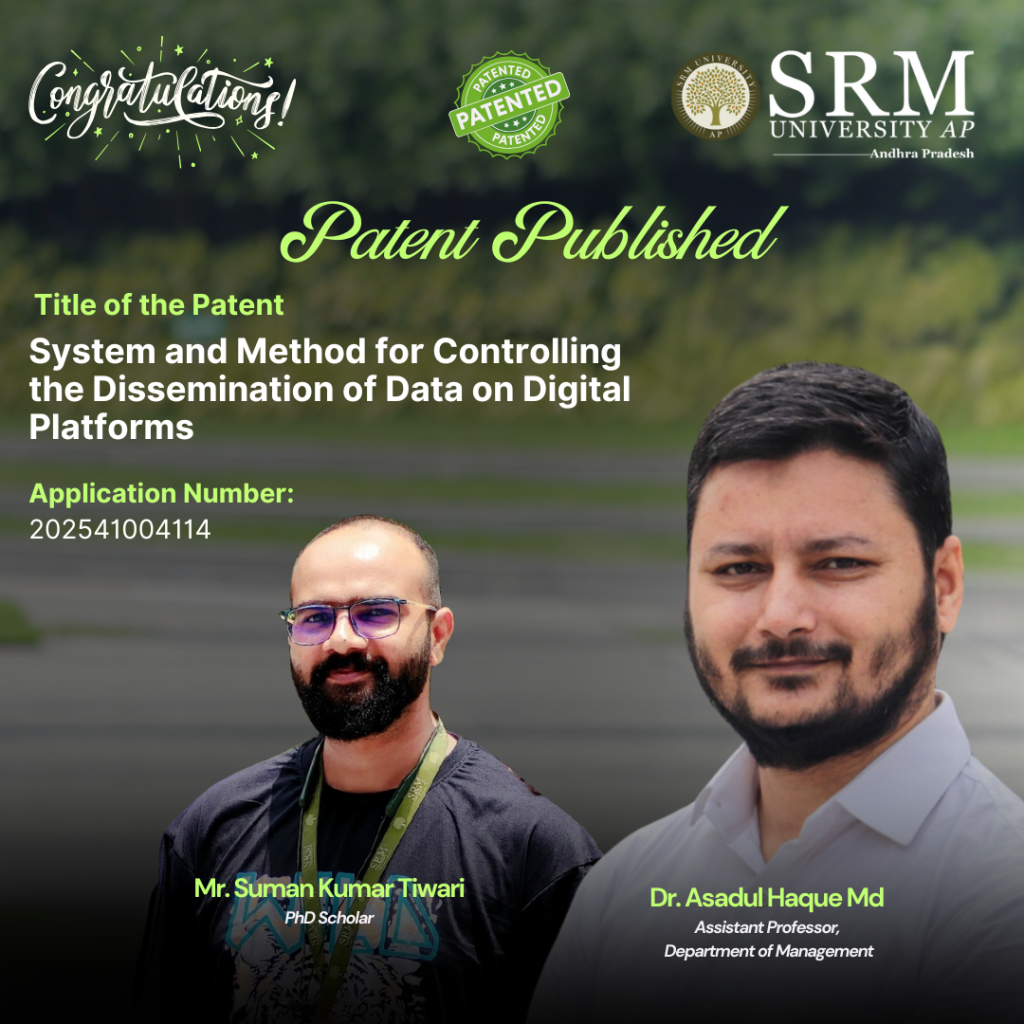 The patent titled “System and Method for Controlling the Dissemination of Data on Digital Platforms,” authored by Assistant Professor, Dr M Asadul Haque from the Department of Management and his research Scholar Mr Suman Kumar Tiwari offers an innovative approach to enhancing advertising strategies on digital platforms. With application number 202541004114, their patent outlines a comprehensive system that utilises real-time data collection and analysis to optimise consumer engagement and improve brand effectiveness in the ever-evolving landscape of social media advertising.
The patent titled “System and Method for Controlling the Dissemination of Data on Digital Platforms,” authored by Assistant Professor, Dr M Asadul Haque from the Department of Management and his research Scholar Mr Suman Kumar Tiwari offers an innovative approach to enhancing advertising strategies on digital platforms. With application number 202541004114, their patent outlines a comprehensive system that utilises real-time data collection and analysis to optimise consumer engagement and improve brand effectiveness in the ever-evolving landscape of social media advertising.Abstract
The patent outlines a novel system and method for optimizing the dissemination of data on digital platforms, specifically targeting the enhancement of advertising strategies through real time data collection and analysis. This system leverages APIs and web scraping for continuous, up-to-date consumer behaviour monitoring, enabling brands to make immediate adjustments to their advertising tactics based on current trends and insights. It employs advanced machine learning algorithms and sentiment analysis to detect intricate consumer response patterns, offering a nuanced understanding of advertisement effectiveness. Additionally, the system supports dynamic strategy optimization, facilitating real-time adjustments to advertising efforts in response to market and consumer behaviour shifts. It incorporates a holistic evaluation approach, considering various mediating and moderating factors such as consumer attitudes and platform types. Designed for scalability across multiple social media platforms, the system ensures compliance with data privacy regulations while performing real-time data collection and analysis. Ultimately, this patent presents a comprehensive feedback system aimed at improving consumer engagement and conversion rates through personalized and effective advertising strategies.
Explanation in Layperson’s terms
The research presents an innovative system aimed at improving advertising strategies on social media platforms. This smart system uses data analysis and machine learning to help brands understand the impact of their ads on consumer buying decisions. By collecting and analysing data from social media, it considers various factors such as ad content, social trends, and consumer sentiments. The system can predict the effectiveness of different advertising strategies before they are implemented, enabling brands to make informed decisions.
Traditional methods focus on basic metrics like ad clicks, but this invention provides a comprehensive view of what influences consumer behavior. It allows brands to adjust their advertising strategies in real-time based on consumer reactions, making campaigns more effective.
Benefits for businesses include better consumer engagement, higher sales, data-driven decision-making, and more efficient use of advertising budgets. The technology is particularly valuable for marketing agencies, online retailers, consumer product companies, and tech startups focused on marketing solutions.
Practical Implementation
The practical implementation of the new advertising system involves several key steps to ensure its effectiveness and ethical use. Firstly, the system integrates with existing social media platforms and advertising tools like Facebook Ads and Google Ads, enhancing advertising strategies. To ensure successful adoption, companies need to provide comprehensive training and support for their marketing teams, enabling them to use the new tools and interpret insights effectively. Before a full-scale rollout, businesses can conduct pilot programs to test the system on a smaller scale and make necessary adjustments based on real-world results. Ensuring adherence to data privacy regulations, such as GDPR, is crucial for the responsible and ethical handling of consumer data. Additionally, the system can be customized to meet the specific needs of various industries, by analysing sector-specific consumer behaviour and trends, which ensures tailored and effective advertising strategies.
Social Implications
The social implications of implementing the new advertising system are multifaceted. Firstly, it enhances consumer awareness by enabling brands to create more relevant and personalized advertisements, thus improving consumer experience and engagement. However, there is a potential risk of market saturation, where the overuse of similar strategies by multiple brands could overwhelm consumers with excessive ads. Privacy concerns are also significant, as increased data collection necessitates a careful balance between effective targeting and respecting consumer privacy. Additionally, automation and advanced analytics may shift job roles within marketing teams, prompting the need for reskilling towards more strategic, creative, and analytical tasks. The system promotes ethical marketing practices by leveraging data-driven insights to prevent misleading advertisements and ensure truthful marketing messages. Lastly, by understanding consumer sentiment, brands can influence societal trends and public perceptions, particularly through socially responsible marketing efforts.
Future Research Plans
• Exploration of Data Privacy Solutions- Investigate methods to enhance data privacy and security while still leveraging consumer data for effective advertising.
• Longitudinal Studies on Consumer Behaviour- Conduct longitudinal studies to understand how consumer behaviour changes over time in response to targeted advertising.
Continue reading → - Relevance of Mahatma Gandhi Reiterated February 27, 2025
The Hans India
Continue reading →

- National Symposium on Rethinking Gandhi in Contemporary Times February 27, 2025
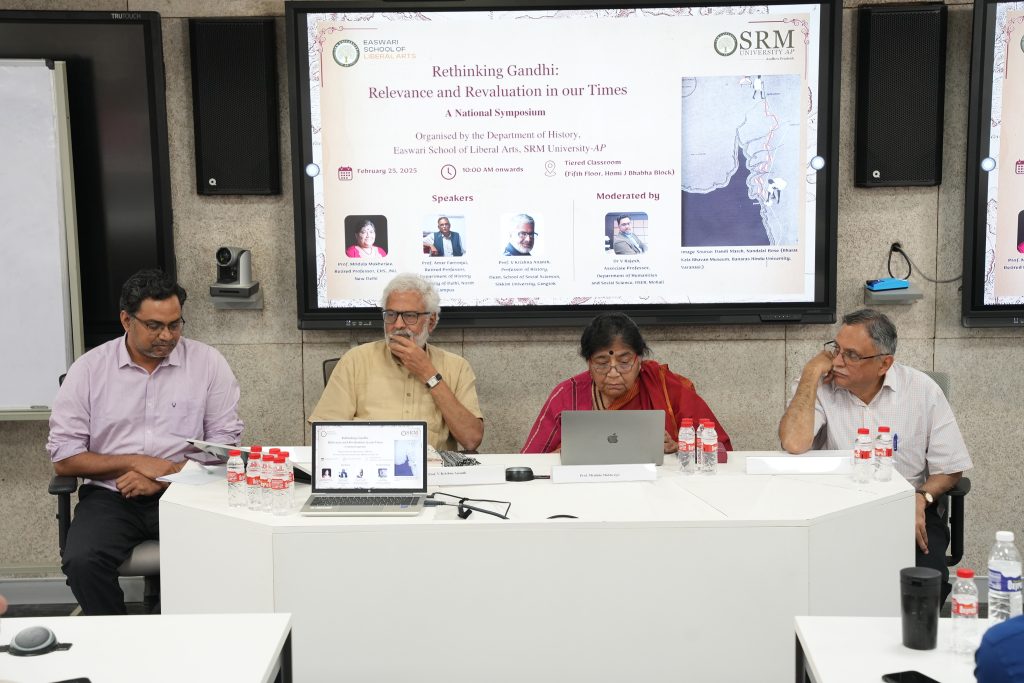
The Department of History from the Easwari School of Liberal Arts, hosted a national symposium on “Rethinking Gandhi: Relevance and Revaluation in our Times,” focusing on the facets of Gandhian legacy of meditation and tolerance. The symposium, held on February 25, 2025, witnessed an assembly of noted stalwarts of Gandhian Studies and modern South Asian history whose expertise in unpacking Gandhi and his politics is noteworthy. Prof. Mridula Mukherjee, Retired professor, JNU, Prof. Amar Farooqui, Retired professor, University of Delhi-North Campus, Prof. V Krishna Ananth, Professor of History, Dean of the School of Social Sciences, Sikkim University, Gangtok, delivered insightful sessions at the symposium moderated by Dr V Rajesh, Associate Professor, Department of Humanities and Social Science, IISER, Mohali.
Prof. Vishnupad, Dean of Easwari School of Liberal Arts, gave a comprehensive account of the relevance of revisiting the Gandhian legacy and ideology of inclusivity, compromise and tolerance in the contemporary world. He also opined the importance of liberal arts education in redefining oneself and shaping young minds into leaders and change-makers of tomorrow.
The symposium highlighted three perceptive lectures by leading academicians in Gandhian Studies. Prof. Mridula Mukherjee elucidated Gandhi as a leader of civil liberties. She commented, “Gandi’s doctrine placed democracy, civil liberties, and the notion of dissent in the forefront. His political ideology played with the terrains of legality and legitimacy.” Prof. Amar Farooqui discussed Gandhi’s relevance, particularly in relation to the idea of secularism. He commented, “Gandhi is uncompromisingly secular” and emphasised that Gandhi’s understanding of secularism remains relevant today.
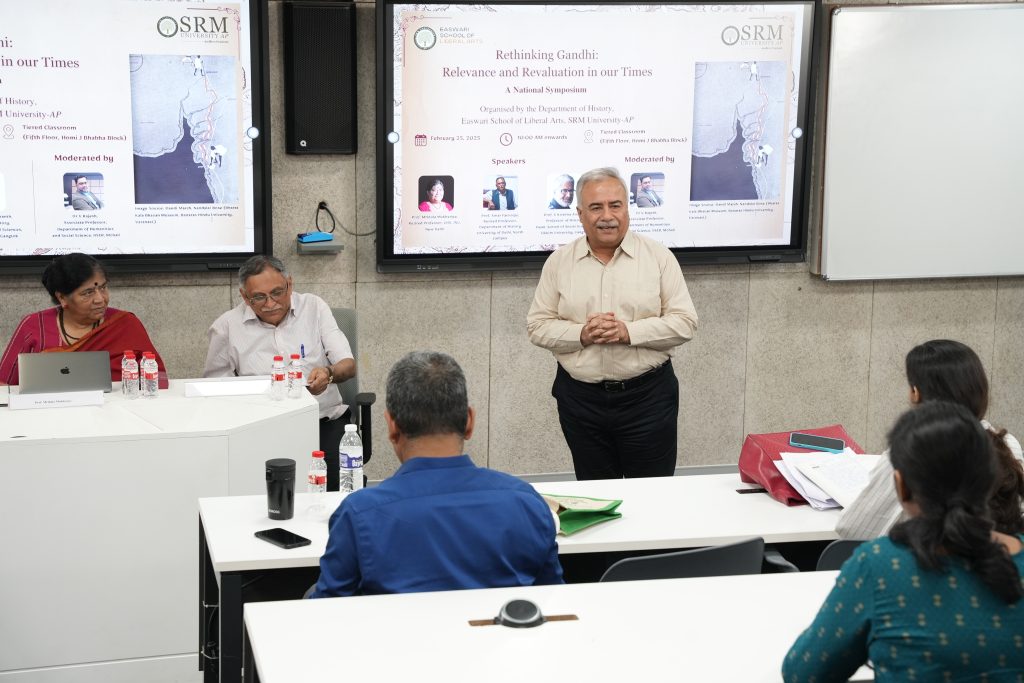
Prof. V Krishna Ananth highlighted that tolerance was central to Gandhi’s journey. He remarked that Gaandhi’s activism exposed the exploitative nexus between colonialism and financial power, a reality that remains relevant today. Dr V Rajesh moderated a Q&A session following the lectures.
Vice Chancellor Prof. Manoj K Arora expressed his appreciation to the Department of History and the Easwari School of Liberal Arts for this formidable initiative. He stated, “The National symposium is hugely beneficial for liberal arts students to enlighten the idea of swaraj. It is important for young minds to imbibe Gandhi’s teachings to strive towards a right and judicious world”.
The symposium aimed at revisiting Gandhi’s legacy, ideology, and vision and their relevance in the contemporary world. The event featured the participation of the Associate Dean of Easwari School of Liberal Arts, Prof. Vandana Swami, Head-Department of History Dr Aqsa Agha, Convenor of the symposium, Dr Maanvender Singh, faculty from the Liberal Arts school, research scholars, and students.
Continue reading →


